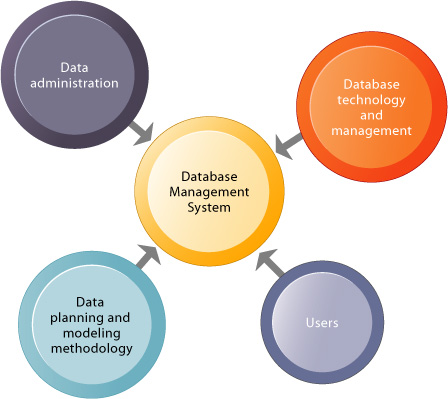| Section 7.5: Full Text |
Chapter
Contents | View Full Text | View
Bullet Text |
| Opportunities |
| Management Challenges |
| Solution Guidelines |
MANAGEMENT OPPORTUNITIES, CHALLENGES, AND SOLUTIONS
Effectively managing the organizationís data resources requires much more than simply
selecting a logical database model. The database is an organizational discipline, a method,
not just a tool or technology. It requires organizational and conceptual change. Management
commitment and understanding are essential.
Opportunities
Firms have become acutely aware of how much organizational performance can be
improved by making better use of their data, as the examples in this chapter and other
chapters of the text so clearly illustrate. This is why so many companies are investing in
data mining and customer relationship management technology.
Management Challenges
It has been very difficult for organizations to manage their data effectively. A true database
environment requires an organization to change the way it defines and uses data and typically
represents a very large investment.
ORGANIZATIONAL OBSTACLES TO A DATABASE
ENVIRONMENT
Implementing a database requires widespread organizational change in the role of information
(and information managers), the allocation of power at senior levels, the ownership
and sharing of information, and patterns of organizational agreement. A database
management system (DBMS) challenges the existing power arrangements in an organization
and for that reason often generates political resistance. In a traditional file environment,
each department constructed files and programs to fulfill its specific needs. Now,
with a database, files and programs must be built that take into account the whole organizationís
interest in data. Although the organization has spent the money on hardware and
software for a database environment, it may not reap the benefits it should if it is unwilling
to make the requisite organizational changes.
COST/BENEFIT CONSIDERATIONS
Designing a database to serve the enterprise can be a lengthy and costly process. In addition
to the cost of DBMS software, related hardware, and data modeling, organizations
should anticipate heavy expenditures for integrating, merging, and standardizing data
from different systems and functional areas. Despite the clear advantages of the DBMS,
the short-term costs of developing a DBMS often appear to be as great as the benefits. It
may take time for the database to provide value.
Solution Guidelines
The critical elements for creating a database environment are (1) data administration, (2) data-planning and modeling methodology, (3) database technology and management, and (4) users. This environment is depicted in Figure 7-18.
 |
FIGURE 7-18 Key organizational elements in the database environment
For a database management system
to flourish in any organization,
data administration functions
and data-planning and
modeling methodologies must
be coordinated with database
technology and management.
Resources must be devoted to
train end users to use databases
properly.
DATA ADMINISTRATION
Database systems require that the organization recognize the strategic role of information and begin actively to manage and plan for information as a corporate resource. This means that the organization must develop a data administration function with the power to define information requirements for the entire company and with direct access to senior management. The chief information officer (CIO) or vice president of information becomes the primary advocate in the organization for database systems.
Data administration is responsible for the specific policies and procedures through which data can be managed as an organizational resource. These responsibilities include developing information policy, planning for data, overseeing logical database design and data dictionary development, and monitoring how information systems specialists and end-user groups use data.
The fundamental principle of data administration is that all data are the property of the organization as a whole. Data cannot belong exclusively to any one business area or organizational unit. All data should be available to any group that requires them to fulfill its mission. An organization needs to formulate an information policy that specifies its rules for sharing, disseminating, acquiring, standardizing, classifying, and inventorying information throughout the organization. Information policy lays out specific procedures and accountabilities, specifying which organizational units share information, where information can be distributed, and who is responsible for updating and maintaining the information. Although data administration is a very important organizational function, it has proved very challenging to implement.
DATA-PLANNING AND MODELING METHODOLOGY
The organizational interests served by the DBMS are much broader than those in the traditional file environment; therefore, the organization requires enterprise-wide planning for data. Enterprise analysis, which addresses the information requirements of the entire organization (as opposed to the requirements of individual applications), is needed to develop databases. The purpose of enterprise analysis is to identify the key entities, attributes, and relationships that constitute the organizationís data. These techniques are described in greater detail in Chapter 14.
DATABASE TECHNOLOGY, MANAGEMENT, AND USERS
Databases require new software and a new staff specially trained in DBMS techniques, as well as new data management structures. Most corporations develop a database design and management group within the corporate information systems division that is responsible for defining and organizing the structure and content of the database and maintaining the database. In close cooperation with users, the design group establishes the physical database, the logical relations among elements, and the access rules and procedures. The functions it performs are called database administration.
A database serves a wider community of users than traditional systems. Relational systems with user-friendly query languages permit employees who are not computer specialists to access large databases. In addition, users include trained computer specialists. To optimize access for nonspecialists, more resourcesmust be devoted to training end users.